Society of California Pioneers - from
Wikipedia
| Established in 1850, the Society of California Pioneers
is dedicated to the study and enjoyment of California art, history, and
culture. Founded by individuals arriving in California before 1850 and
thriving under the leadership of several generations of their direct descendants,
The Society has continuously served its members, the academic community,
and the public. As the oldest organization West of The Mississippi, The
Society opened the first library in California, as well as a grand hall
for meetings, lectures, and social events. Today The Society operates a
public museum and a research library, both housed in one of the iconic
Montgomery Barracks Buildings on The Presidio of San Francisco’s historic
Main Post.
Pioneer Hall features rotating exhibitions of art and
artifacts amassed since 1850; free museum education programs for school-aged
children, as well as public tours and events are offered. The Alice Phelan
Sullivan Research Library, which houses a large portion of The Society’s
collections, is open to the public by appointment, allowing researchers
and historians access to The Society’s privately held repository of rare
primary source materials.
The Society's service to the community is designed to
support scholarship and encourage new interpretations that illuminate and
honor the diverse experiences of those who came before us.
According to its constitution, The Society's mission is
"to collect and preserve information connected with the early settlement
and formation of this new state."
The Society continues to be a membership organization,
and "Membership is open to direct descendants of those who arrived in California
prior to January 1, 1850."
Museum |
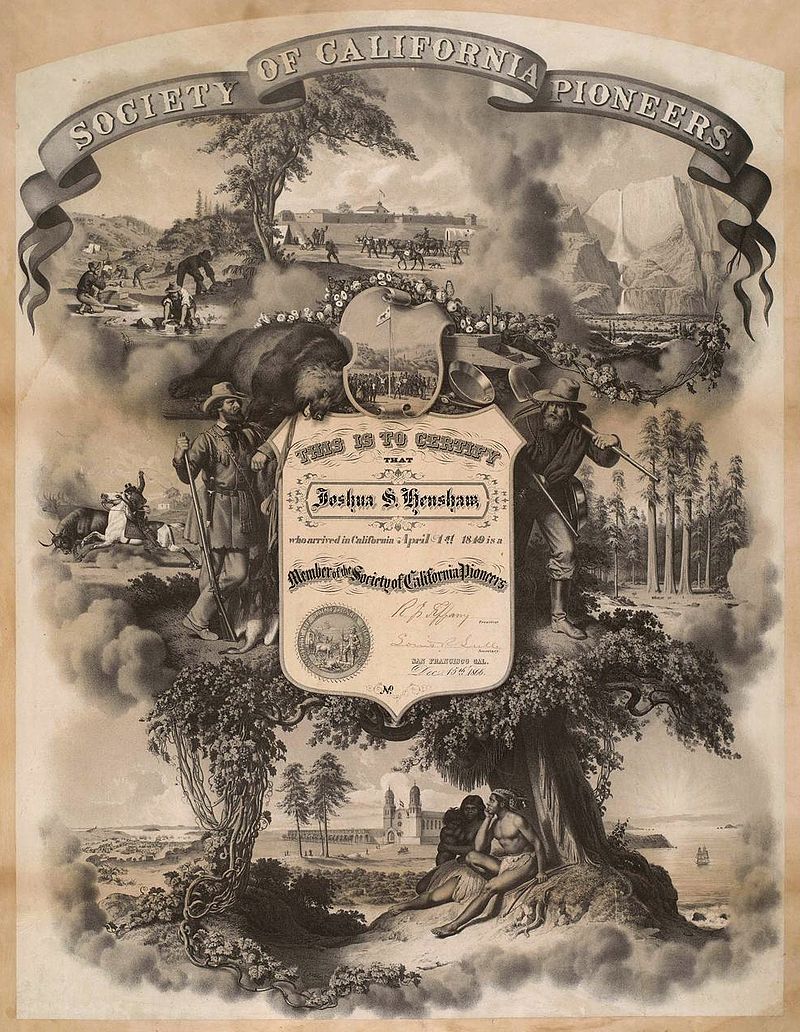
Society of California Pioneers membership
certificate issued to Joshua S. Henshaw,
December 15, 1866 |
The Society continues to exist and has its headquarters in
San Francisco. Pioneer Hall at The Presidio, which includes a museum (open
to the public Wednesday to Sunday) and a research library (open by appointment
only) is on the historic Main Post at 101 Montgomery, Suite 150 - Presidio
of San Francisco, 94129.
The Society of California Pioneers’ archives document
the founding and early history of California, including The Gold Rush,
The Earthquake and Fire of 1906, and other defining events. The collection
includes manuscripts and letters, paintings, prints and drawings, photographs,
books, maps, newspapers and journals, the business ledgers of mining and
transportation companies, as well as historic artifacts and decorative
objects. An extensive collection of overland and pioneer diaries includes
those of John A. Sutter and a letter by Henry W. Bigler, both primary sources
announcing the discovery of gold in California. Works by Carleton Watkins,
Eadweard Muybridge, Lawrence & Houseworth, and Turrill & Miller
are held in our archive of photographs, panoramas, and daguerreotypes.
Particularly notable for its nineteenth-century holdings, the painting
collection includes works by Thomas Hill, William Coulter, Jules Tavernier,
and Maynard Dixon. Together with The Society’s collection of ephemera and
prints, these form a vivid, visual record of life in California over time.
The museum exhibits art and artifacts from the Society's
collections on a rotating basis.
|
| Jim Levy (gunfighter) - from
Wikipedia
James H. Levy (1842 – June 5, 1882), or Leavy, was a Jewish
gunfighter in the Old West. He is remembered today by Western historians
for participating in at least two instances of a quick draw duel. In his
time, Levy was one of the most notorious gunmen in the Old West known for
challenging other gunmen to a duel. He is featured in the book Deadly Dozen,
written by author Robert K. DeArment as one of the twelve most underrated
gunmen of the 19th century West.
Historian Erik J. Wright notes that Levy's names was in
fact spelled "Leavy" as it was spelled this way on a number of primary
documents from his time in Nevada and Arizona.
Early life
Jim Levy was born in Dublin, Ireland in 1842 of Jewish
parents. While he was young, his parents took him with them and immigrated
to the United States. By 1871, Levy headed out West to Pioche, Nevada and
worked as a miner. In May of that same year, Jim witnessed a gunfight between
Michael Casey and Tom Gasson. Gasson was mortally wounded in the shootout,
but before dying he promised a reward of $5,000 to anyone who could avenge
his death. During the investigation that followed, Casey stated he shot
the man in self-defense, but soon after Levy testified against him, saying
that it was Casey who shot first. This infuriated Casey and he hunted down
Levy.
While many historians claim Leavy/Levy was of Jewish descent,
no proof of this exists.
Gunfights
First duel
Casey managed to track down Levy in a local store and
wasted no time in challenging him to a duel. Levy accepted his challenge,
but excused himself first to get a firearm. The two decided to meet in
an alleyway behind the store. After getting his gun, Levy called out to
Casey and they finally squared off. Levy managed to shoot first, grazing
Casey's skull, before firing again, this time hitting Casey in the neck.
As the latter fell to the ground heavily wounded, Levy charged towards
him and hit him in the head with his pistol. Unfortunately for Levy, a
companion of Casey was also in the alleyway, and he retaliated by shooting
Levy in the jaw, forever disfiguring his face.
Levy was soon after arrested but was later acquitted for
self-defense. Levy then collected his bounty and resigned from his job
as a miner. He traveled to Virginia City, Nevada; to Cheyenne, Wyoming;
Deadwood, South Dakota; Leadville, Colorado; and Arizona—to Tombstone,
and Tucson for the next 10 years, now working as a professional gambler
and gunman. In 1873, it was reported that he had another gunfight with
a man named Thomas Ryan before leaving Nevada, but he was again acquitted.
It is also estimated that during that time, Levy fought and survived over
sixteen shootouts.
Second duel
In the night of March 9, 1877 in Shingle & Locke's
Saloon in Cheyenne, Wyoming, Levy had an argument with another infamous
gunfighter named Charlie Harrison over a game of cards. Levy was said to
have insulted Harrison's background as an Irishman and the two decided
to duke it out outside. After leaving the saloon, the two faced off in
the streets with a group of onlookers watching them. Harrison already had
a reputation as a deadly gunman, and onlookers reported that they thought
that Harrison would easily win the duel.
The two then moved in front of the Senate Saloon before
finally stopping at Eddy Street. Both gunmen drew their pistols at the
same time, and Harrison managed to shoot first but missed. Levy followed
soon after but his bullet hit its mark, landing in Harrison's torso. Harrison
was then taken to a hotel to be treated, but would die from his wound a
week later. Levy faced charges due to the murder but he was never convicted
or punished.
Third duel and death
Jim Levy, by 1882, had already built a reputation of having
fought in at least 16 gunfights. On June 5, 1882, Levy had another argument
with a faro dealer named John Murphy in Tucson, Arizona. The two agreed
to have a duel on the Mexican border, but after hearing of Levy's exploits
as a gunfighter, Murphy decided to ambush Levy instead. Together with two
of his friends, Murphy ambushed Levy as he was leaving the Palace Hotel,
killing him. According to Wright, the three co-defendants in Leavy's murder
later escaped from the Pima County Jail and were later recaptured. Murphy
and Gibson were found in Fenner, California living under assumed names
and retried for the murder before being found not guilty. Moyer was captured
in Denver and sentenced to life in Yuma Territorial Prison, but was pardoned
in 1888.
Murphy lived his life as a gambler in southern Arizona
and is buried in Tucson. Gibson continued to work in mining and prospecting
and died in Prescott, Arizona. Moyer, however, worked at periods as a hired
gun and was involved in the notable Johnnie Mine fight in Nevada in 1895.
He was last seen in Alaska around the turn of the twentieth century.
Legacy
Although he is virtually unheard of today, Levy was one
of the most notorious gunfighters of his time. Both Bat Masterson and Wyatt
Earp mentioned his name and his abilities. Earp praised Levy for his practical
approach in a gunfight, leaving out fast draw theatrics and opting for
calm accuracy instead.
Jim Levy is included in a list of twelve most underrated
and less-popular gunfighters in history, in the book Deadly Dozen by author
Robert K. DeArment.
|
Mattie Silks - from Wikipedia
Mattie Silks, or Martha Ready (1846– 7 January 1929),
was a prostitute, leading madam and brothel keeper in the late 19th century
American West.
Early life
Silks was born in Fayette County, Pennsylvania and raised
in Indiana. Having worked as a prostitute in Abilene, Texas and Dodge City,
Kansas, she became madam of a brothel in Springfield, Illinois in 1865
at the age of 19. She became one of the best known madams in the west,
having brothels in Dodge City, Georgetown, Colorado and Denver, Colorado,
where demand for women was high due to the Colorado gold rushes.
Life in Denver
Silks was described as a very good looking woman, with
spirit and a competitive nature. She bought her first brothel on Holladay
Street (now Market Street) from Nellie French for $13,000 and suffered
from stiff competition from other brothels. At one point, she and another
madam, Kate Fulton, had the first recorded duel in Denver between two women.
In addition to running competing brothels, both were involved romantically
with the same man, Cortez Thomson, a local businessman. Both missed their
targets, but Silks' bullet did strike a bystander, none other than Thomson,
injuring him slightly.
From 1877 to 1897 her brothel was the most successful
in Denver. Silks was known as the “Queen of Denver’s Red Light District”.
In 1898, Madam Jennie Rogers opened the House of Mirrors in Denver, and
quickly became more successful than any of the competition. Jennie Rogers
died in 1909, after which Silks purchased the House of Mirrors for $14,000.
She continued to work as a madam, traveled, and invested in real estate,
making her a very wealthy woman. |
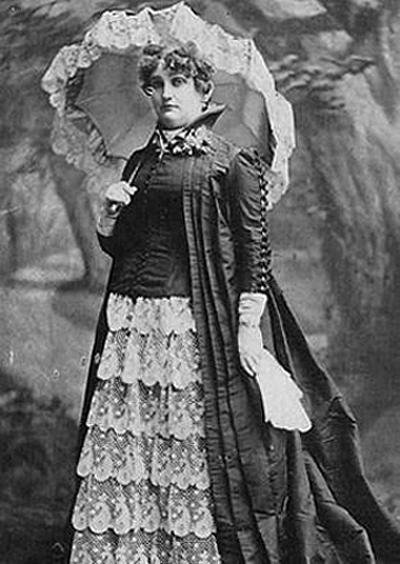
Mattie Silks |
She died in 1929 from complications due to a fall. Very
few people attended her funeral. She was buried under the name Martha Ready,
beside her longtime lover Cortez Thomson, in block 12-lot 31, of Fairmount
Cemetery in Denver. Silks left $4,000 in real estate and $2,500 in jewels.
|
Texas Jack Omohundro - from Wikipedia
John Baker Omohundro (July 26, 1846 – June 28, 1880),
also known as "Texas Jack," was an American frontier scout, actor, and
cowboy. Born in rural Virginia he served in the Confederacy during the
American Civil War and later as a civilian scout for the US Army during
the Indian Wars. Before his untimely death, Texas Jack became a legendary
figure in the American Old West as a western showman performing dramas
on the stage throughout the country, and was immortalized in dime novels
published around the world.
Early life
Omohundro was born in Palmyra on the Pleasure Hill farm
in Fluvanna County, Virginia, on July 26, 1846, to John Burwell and Catherine
Baker Omohundro of Anglo-American ancestry. He attended grammar school
in Fluvanna and at an early age showed a strong skill in hunting and fishing.
At the start of the American Civil War, Omohundro attempted
to join his older brother, Orville, in the Confederate Army. He was twice
refused for his age, but was allowed to serve as a courier at the headquarters
of the Virginia Militia under Major General John B. Floyd. Because of his
youth and knowledge of the countryside he became known as the "Boy Scout
of the Confederacy". In February 1864, at the age of 17, he successfully
enlisted as a private in Company G of the 5th Virginia Cavalry, part of
the Army of Northern Virginia, and was soon serving directly in General
J.E.B. Stuart's command as a courier and scout. At the Battle of Yellow
Tavern he delivered a scouting report to J.E.B. Stuart only minutes before
the General was killed in battle. During the Battle of Trevilian Station,
Omohundro was wounded and admitted to the Confederate States General Hospital
in Charlottesville on June 20, 1864. After recovering from his injuries,
and a short leave home, he returned to his Company and scouted under the
command of General |
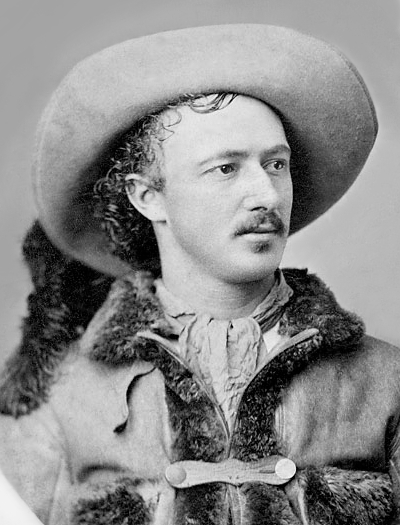
John Baker Omohundro
July 26, 1846 |
Lunsford Lomax. Following the Third Battle of Winchester,
the 5th Virginia Cavalry was consolidated with the 15th Virginia Cavalry,
where Omohundro scouted under General Fitzhugh Lee during the last months
of the war.
Cowboy, hunting, and scouting career
After the Civil War, Omohundro left Virginia at age 19
for Florida. After a short time he moved on to Texas, arriving at the Taylor
Ranch near Brazos, where he began working as a cowboy participating in
cattle drives, notably on the Chisholm Trail. After one drive across Arkansas
to a meat-poor Tennessee, he was given nickname "Texas Jack" by the locals.
On another drive, Omohundro found a five-year-old boy orphaned after a
Native American raid killed his family. He brought the boy to safety in
Fort Worth, and the boy later took the name Texas Jack Jr. in homage, going
on to run the Texas Jack's Wild West Show and Circus in 1903 in South Africa.
In 1869, Texas Jack moved to Fort Hays, Kansas, where
he met California Joe Milner and Wild Bill Hickok, the latter being sheriff
of Ellis County at the time. Later that year, Jack met and befriended William
F. "Buffalo Bill" Cody, who was working with the 5th U.S. Cavalry at Fort
McPherson, and Jack was hired as a scout and trail guide during the Indian
Wars. Special permission had to be obtained as the U.S. Government did
not generally permit the employment of ex-Confederate soldiers. During
the Battle of Summit Springs, Texas Jack captured his well known white
horse from Indian Chief Tall Bull. Texas Jack moved to Cottonwood Springs,
Nebraska, where, aside from his work as a scout for the government, he
made a lucrative living leading hunting expeditions for American and foreign
parties which were popular at the time. Notably, Texas Jack, together with
Cody, led the highly publicized royal hunt of 1872 with Grand Duke Alexei
of Russia and several American military figures, including General Philip
Sheridan, General George Custer, and Colonel James Forsyth. Later in 1874,
Texas Jack guided the Earl of Dunraven though Yellowstone and Geyserland.
In 1876, Texas Jack led Sir John Rea Reid and his party on a hunt around
the Bighorn Mountains and Sweetwater country.
Acting
| In December 1872, Omohundro and Cody debuted the first
Wild West show, Scouts of the Prairie, in Chicago written and produced
by Ned Buntline. Texas Jack's performance was well-received by critics
and featured the first rope act performed on the American stage. The show
starred Giuseppina Morlacchi, a dancer and actress from Milan, Italy, who
was performing in the theater circuit with her Morlacchi Ballet Troupe
when she was invited to join Scouts of the Prairie with the group. She
and Texas Jack fell in love and were married on August 31, 1873 at St.
Mary's Catholic Church in Rochester, NY.
In 1873, Buntline left, and Wild Bill Hickok joined the
group to headline in a new play called Scouts of the Plains. Hickok did
not enjoy acting, often hiding behind scenery, and in one show he shot
the spotlight when it focused on him. He was released from the group after
a few months.
Desiring a lighter tour schedule, Texas Jack parted ways
with Cody, and in 1877 he formed his own acting troupe in St. Louis, known
as the Texas Jack Combination featuring Morlacchi, Arizona John Burke,
the Modoc War scout Donald McKay, trick-shot Maud Oswald, and several Sweetwater
& Warm Spring Indians. In May of that year he debuted Texas Jack in
the Black Hills, written by Harry Seymour, to rave reviews. Other plays
the combination performed included The Trappers Daughter, Life on the Border,
and The French Spy.
Dime novels
In the late 19th century, dime novels depicting frontier
life were becoming common, and Texas Jack became a popular subject of these
stories. The dime novels, printed on inexpensive wood pulp paper and costing
five to ten cents each, were published weekly or monthly. One of the first
of these novels was titled Texas Jack; or The White King of the Pawnees,
written by Ned Buntline, and first appeared in 1872. Texas Jack's popularity
grew as he was featured on covers by publishers including Beadle's New
York Dime Library, The Nickle Library, Log Cabin Library, DeWitt's Ten
Cent, Street and Smith, and others. Many of these stories were written
by the prolific author Col. Prentiss Ingraham. Omohundro wrote articles
in newspapers across the country recalling his hunting and scouting stories,
and is credited as having authored one dime novel titled Ned Wylde, the
Boy Scout for Beadle and Adams in 1876.
In 1900, Joel Chandler Harris wrote On the Wing of Occasions,
a series for the Saturday Evening Post, that featured Texas Jack and the
Confederate Secret Service in a fictional plot to kidnap President Lincoln.
At the time the stories caused some outrage since it associated Texas Jack
with John Wilkes Booth, and after publication Harris received several letters
objecting to Texas Jack's portrayal and attempts to clear his name.
In 1906, Verlagshaus für Volkslitteratur und Kunst,
Berlin, published a series of dime novels in German, titled "Texas Jack,
Der Grosse Kundschafter" (Texas Jack, The Great Scout). Inspired by Omohundro,
the stories are of the fictional Jack Hawkins, an orphan who becomes a
scout and cowboy in the American West engaging in skirmishes with Indians
and opium smugglers, while some stories are set during the Mormon War and
in Maximilian's Mexico. In Germany the novels were republished in three
subsequent series, and they were translated into eight languages - French
"Texas Jack, la Terreur Des Indiens" (Texas Jack, the Terror of the Indians),
Swedish "Texas Jack, Amerikas mest berömde indianbekämpare" (Texas
Jack, Americas Famous Indian Fighter), Finnish, Danish, Polish, Dutch,
Portuguese, and Italian.
In 1966, Lion, a weekly comic by Fleetway, published a
series about Omohundro titled "Texas Jack", which was released in the United
Kingdom and Australia after earlier success they had with other Western
themed comics such as "Cowboy Comics", "Buffalo Bill", and "Kit Carson".
Unlike earlier dime novels, they were formatted like comics, and the stories
were illustrated using panels. In 1972, the Lion comics were translated
into Spanish and reissued with new cover art by the Rollán publishing
house of Madrid for distribution in Spain.
Death and legacy
Texas Jack and Morlacchi settled in Massachusetts with
a home in downtown Lowell and a small farm in Billerica. In the spring
of 1880, after several performances in the region the couple decided to
sojourn in the silver-mining town of Leadville, Colorado. There Omohundro
became acquainted with Horace Tabor and briefly joined Tabor's Light Cavalry,
a local militia formed to kept order in the newly founded town. A few months
after arriving, Texas Jack contracted a cold which developed into pneumonia,
he died weeks later. The funeral was well-attended, and he was given full
military honors, with several military companies in attendance firing a
three-volley salute as his flag-draped coffin was lowered into the ground.
His final resting place is Evergreen Cemetery in Leadville. Shortly after
Texas Jack's death, Morlacchi returned to their home in Lowell. She never
toured again.
After several years the grave fell into disrepair, and
a traveling group of comedians raised funds to provide for its upkeep.
In 1908, while passing through Leadville, Cody visited the cemetery and
commissioned a granite grave marker for his old friend, mistakenly listing
Texas Jack's age as 39 years.
In 1980, the Texas Jack Association was formed to preserve
and promote Texas Jack's memory.
In 1994, Texas Jack Omohundro was inducted into the National
Cowboy & Western Heritage Museum in the Hall of Great Western Performers |
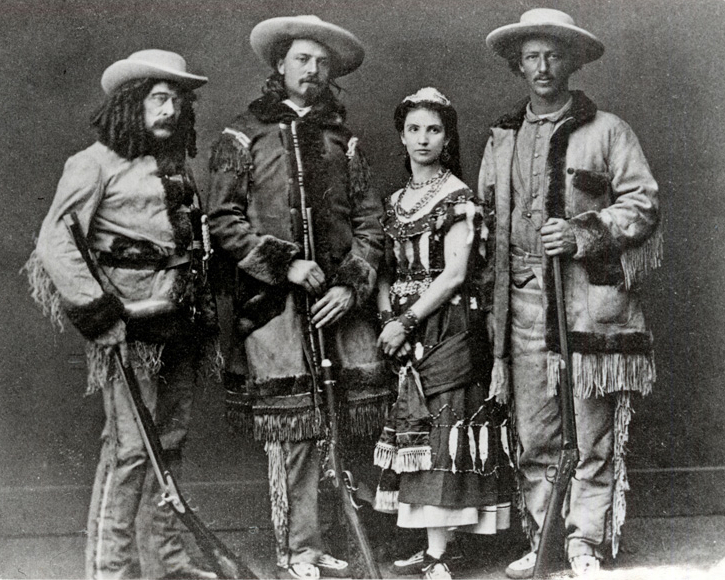
Ned Buntline, Buffalo Bill Cody,
Giuseppina Morlacchi,
Texas Jack Omohundro
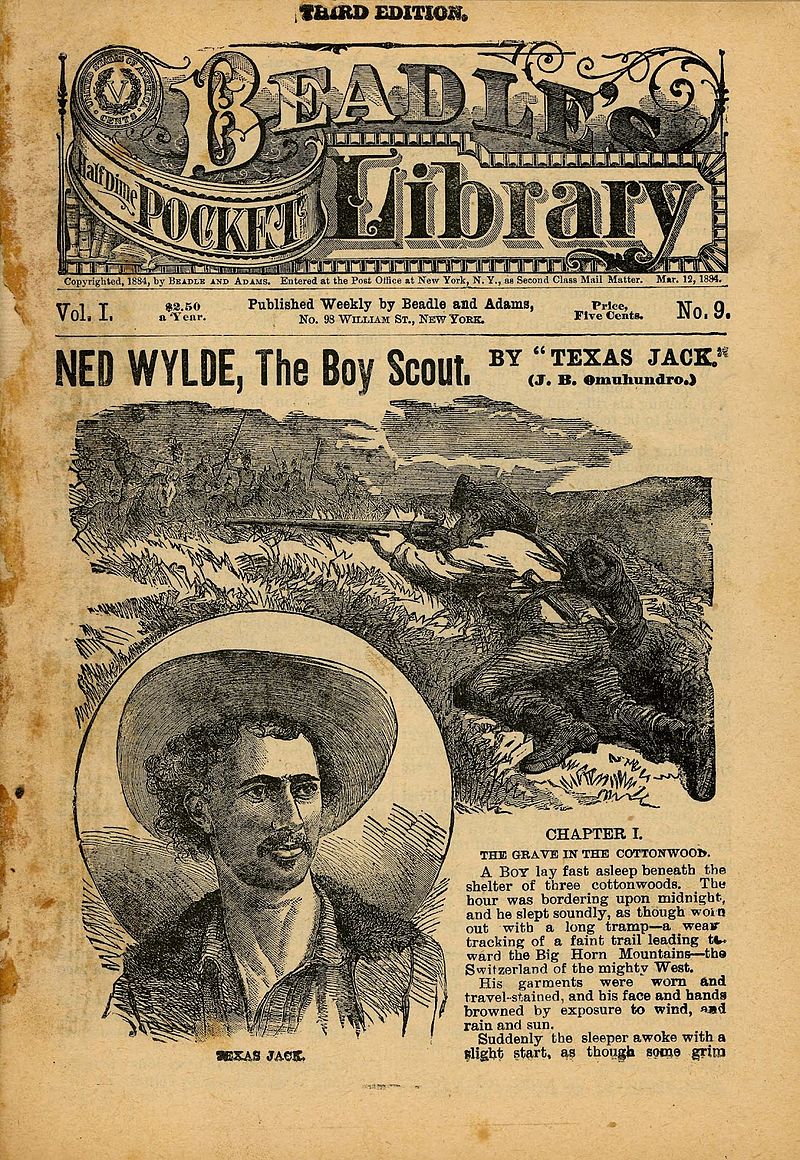
Beadles Dime Novel
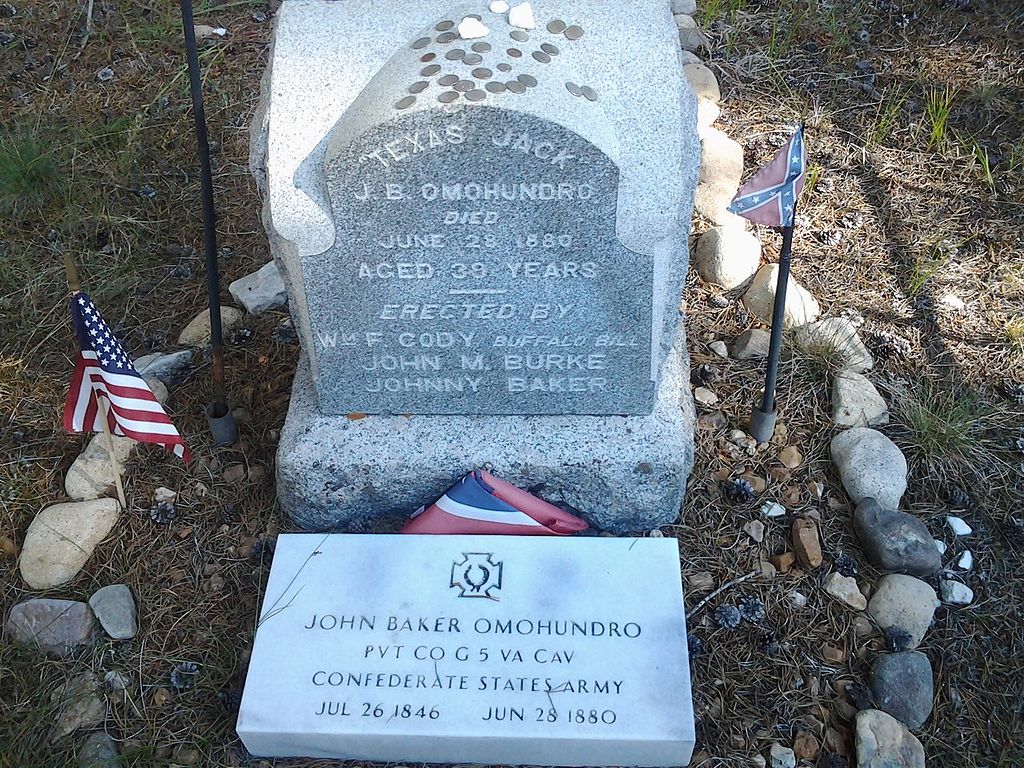
The grave of Texas Jack
in Evergreen Cemetery |
|
.
All articles submitted to the "Brimstone
Gazette" are the property of the author, used with their expressed permission.
The Brimstone Pistoleros are not
responsible for any accidents which may occur from use of loading
data, firearms information, or recommendations published on the Brimstone
Pistoleros web site. |
|